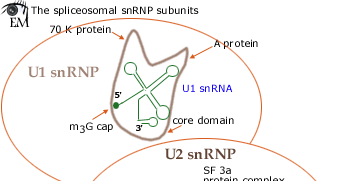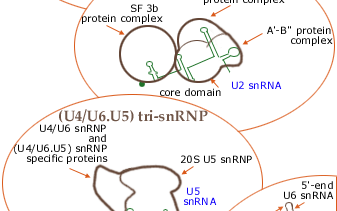Principles of SplicingIn 1977, it was discovered that eucaryotic genes are often split into exons and introns. Both exons and introns are transcribed and the introns have to be excised from the pre-mRNA in order to obtain a continuous reading frame for the translation machinery. The discovery was fundamental and was rewarded with the 1993 Nobel Prize in Physiology or Medicine to Philip Sharp and Richard Roberts.
The splicing reaction has been extensively studied genetically and biochemically to define the molecules involved and the reaction mechanism. Today it is known that five small nuclear RNAs (snRNAs) and approximately 50 different proteins make up the splicing machinery. The five snRNAs are essential splicing factors. Each snRNA is associated with several different proteins to make up five snRNP complexes, called U1, U2, U4, U5 and U6. The snRNAs are transcribed from specific genes, the U1, U2, U4 and U5 snRNAs by RNA polymerase II and the U6 snRNA by RNA polymerase III. The snRNAs (except U6 snRNA) are capped at their 5' end (a trimethylguanosine-cap, slightly different compared to the cap structure of mRNAs) and are transported to the cytoplasm to mature. In the cytoplasm, they bind snRNP specific proteins and their cap structure is somewhat modified before they are mature and are transported back to the cell nucleus. |
||||
|
Based on biochemical experiments, the snRNPs and the protein splicing factors sequentially bind to the pre-mRNA to define the exon-intron borders. The complete complex of splicing factors bound to the pre-mRNA is called a spliceosome. The splicing reaction is a two-step transesterification reaction and it is believed that it is the RNA molecules, not the proteins, that form the active reaction sites. The spliceosome is presumably a dynamic structure in which RNA-RNA base pairing is formed and broken. The proteins are believed to assist by initiating, stabilizing and breaking the RNA-RNA interactions. Splicing is not only an essential step in constitutive gene expression. It is also an important mechanism for regulation of gene expression. A large number of genes can give rise to more than one type of mRNA in a process known as alternative splicing. alternative splicing » |
|||


